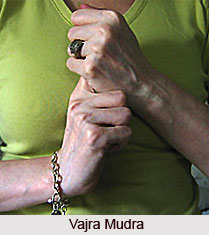 Vajra Mudra is a gesture of the fiery thunderbolt and it stimulates blood circulation within the body. It symbolizes the five elements: air, water, fire, earth, and metal. It is supposed to transform ignorance into wisdom. On the physical plane, Vajra Mudra is believed to stimulate blood circulation and reduce the restlessness and dizziness caused by low blood pressure. In a human body, blood circulation may be weakened when blood pressure is too low, or there is a weakness in the earth element and it is associated with the energy of the stomach, spleen and pancreas, or a weak heart. Consequently, restlessness, and dizziness are developed.
Vajra Mudra is a gesture of the fiery thunderbolt and it stimulates blood circulation within the body. It symbolizes the five elements: air, water, fire, earth, and metal. It is supposed to transform ignorance into wisdom. On the physical plane, Vajra Mudra is believed to stimulate blood circulation and reduce the restlessness and dizziness caused by low blood pressure. In a human body, blood circulation may be weakened when blood pressure is too low, or there is a weakness in the earth element and it is associated with the energy of the stomach, spleen and pancreas, or a weak heart. Consequently, restlessness, and dizziness are developed.
Concept of Mudra
Mudras are symbolic hand gestures that are often used to heal the mind-body. Since ancient times mudras represent a non-verbal form of communication and spiritual expression. They are used as symbols of divine powers or the deities themselves.
Steps of Vajra Mudra
One should practise this Vajra Mudra with each hand three times a day for 5 minutes. This Mudra is practiced with the 3 fingers that involve the middle finger, the ring finger and the little finger.
1. Vajra mudra is formed with both hands raised in front of the heart chakra whereas the index finger of one hand is wrapped and held in the fist of the other hand.
2. The remaining fingers form a fist below.
3. The right-handed people use the palm of the right hand to hold the index finger of their left hand.
4. The left-handed form this mudra with their left hand wrapped around the right index finger.
5. The Vajra mudra can be practised with 3 times a day for 5 minutes.
6. In addition to that relief is achieved by massaging the root of the nose, the center of the forehead, the back of the head and the nape of the neck with the middle finger.
Benefits of Vajra Mudra
Vajra Mudra is a boon for people living a sedentary life. All the office goers experience bouts of dizziness, listlessness and drained energy during mid day. This is a result of poor blood circulation.
•Vajra Mudra improves blood circulation and is good for people suffering from low blood pressure. It stimulates the blood circulation within the body.
•Body gets energized.
•Reduces restlessness and dizziness.
•Vajra Mudra also lets skip stimulants like cigarette, tobacco, tea and coffee. In long run, the consumption pattern will reduce and you can also be habit free.




















